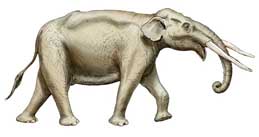RHYNCHOTHERES
· Upper tusk enamel and dentine grows in a spiral pattern winding around
the tusk.
· Compressed enamel-banded lower tusks are characteristic of rhynchotheres.
· Lower tusks angled down sharply.
------------------------------------------------------------------------

Simpson's Spiraltusker
Rhynchotherium simpsoni
· Pronunciation– RINK-o-THEER-ee-um SIMP-son-eye
· In Tusks! exhibit?– Yes, a tusk, and a palate with third
molar
· Florida fossil localities– Bone Valley (Polk County); Dam Site
(Manatee County); Nichols Mine (Polk County); Macasphalt Shell Pit (Sarasota
County)
· Geological time– Very late Miocene, very early Pliocene
· Chronological time– ~7 to 4.5 million years ago
· Enamel completely covers upper tusk.
· Lower tusk often had a straight enamel band.
· Rhynchotherium had sharply down-turned lower tusks and jaw.
· More of a grazer than previously thought.
BACK
TO TIMELINE

Precursor Spiraltusker
Rhynchotherium praecursor
· Pronunciation– RINK-o-THEER-ee-um PRE-cur-ser
· In Tusks! exhibit?– No
· Florida fossil localities– APAC Shell Pit (Sarasota County)
· Geological time– Late Pliocene
· Chronological time– ~2.5 to 2 million years ago
· Lower tusk often had a straight enamel band.
· Downturned mandibles.
· Probably evolved into Cuvieronius tropicus.
BACK TO TIMELINE

Cuvier's Spiraltusker
Cuvieronius tropicus
· Pronunciation– COO-vee-er-O-nee-us TROP-i-cus
· In Tusks! exhibit?– Yes, a mandible with 3rd molar, a
maxilla with 2nd and 3rd molar
· Florida fossil localities– Alachua County; Leisey Shell Pit (Hillsborough
County); Crystal River Power Plant (Citrus County); Punta Gorda (Charlotte County)
· Geological time– Late Pliocene, late middle Pleistocene
· Chronological time– ~2 million years to 500,000 years ago
· Upper tusk spirals with a spiraling enamel band, like Rhynchotherium.
· Lacked lower tusks, unlike Rhynchotherium.
· Downturned mandibles
· Closely related to Rhynchotherium praecursor
· Remains found in association with humans. But apparently not in Florida,
for fossils later than 500,000 years ago have not been found.
· Mixed feeder on tropical savannas
BACK
TO TIMELINE
------------------------------------------------------------------------


